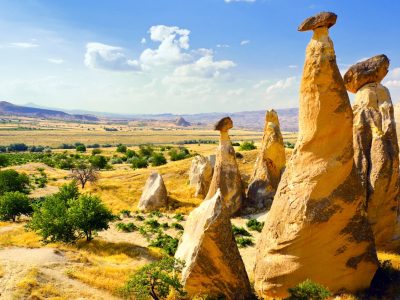Cappadocia Day Tours
The region of Cappadocia is located in the middle of a once-active volcanic area of central Anatolia. Millions of years ago three of its mountains – Erciyes, Hasandağ and Güllüdağ – were active volcanoes; indeed this activity persisted intermittently at least into the Neolithic period according to the prehistoric paintings.
The volcanic eruptions were so strong that in some places the lava was up to 150m in thickness. Over many millions of years, volcanoes, wind, rain and ice sculpted the region which we now know as Cappadocia. As the landscape was eroded, basalt stones remained and formed conical structures with some reaching as high as 45m.
The local people referred to these unique rock formations “fairy chimneys”, a name that has endured throughout the ages. If nature was the first artist to arrange the decor, it was Anatolian man who carved the rock and built houses, churches and over 250 underground cities out of it over the centuries.
Cappadocia
Cappadocia offers visitors an extraordinary and lavish banquet of natural wonders that exceed their wildest imaginations. These wonders are elegantly graced with works created by the hand of man. With its unique natural features displaying a harmonious combination of natural and cultural landscape elements, Cappadocia is an enchanting open-air museum and an unparalleled example of the common cultural heritage of humanity.
Cappadocia incorporates the provinces of Aksaray, Nevşehir, Niğde, Kayseri and Kırşehir. For most people, the name Cappadocia suggests the towns of Uçhisar, Göreme, Avanos, Ürgüp, Derinkuyu, Kaymaklı and Ihlara, where the land has been shaped into fantastic forms over the course of millions of years. Fairy chimneys that seem mysterious and cities and houses of worship that extend many meters deep into the earth are all enveloped in an atmosphere that is ethereal and unworldly.


